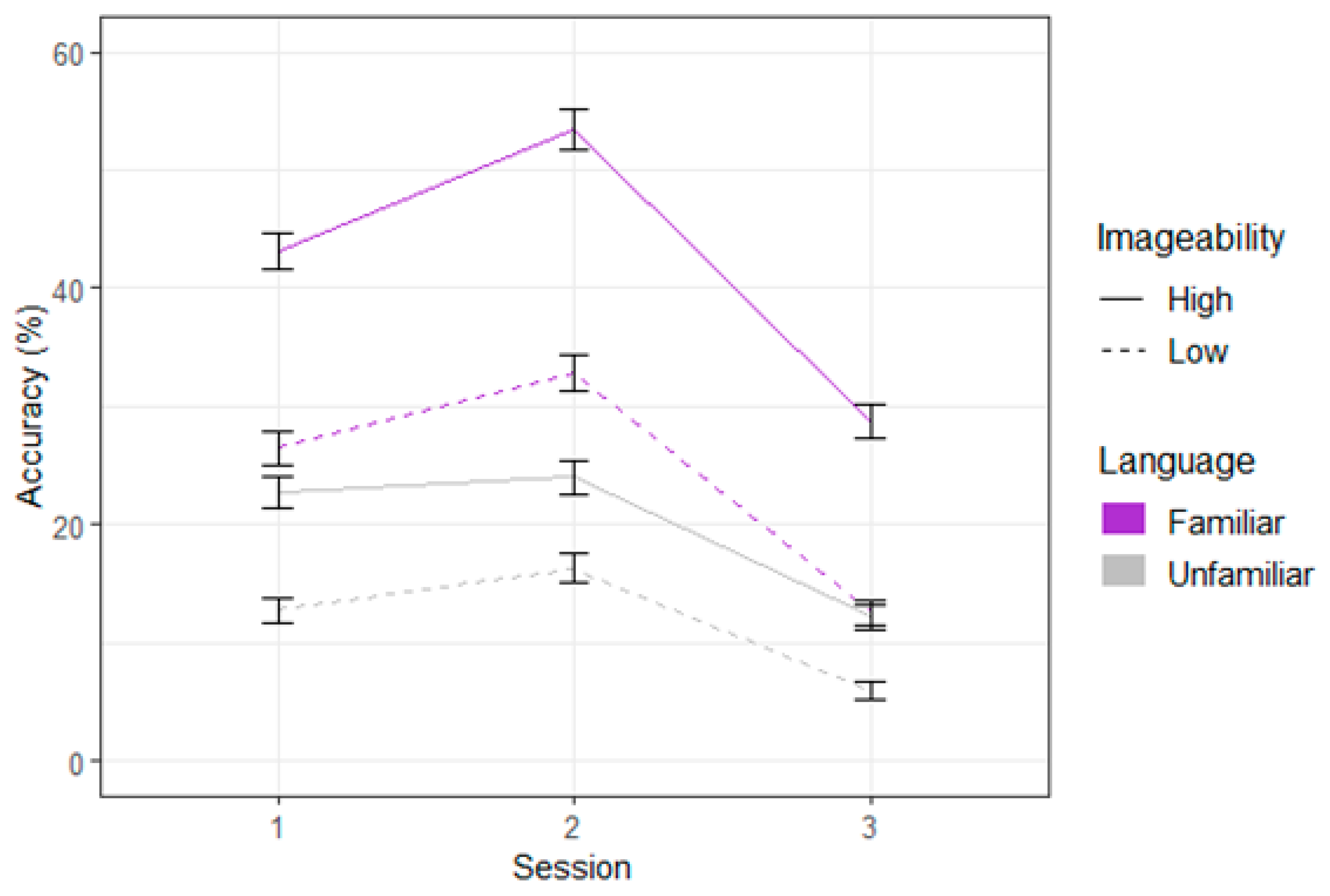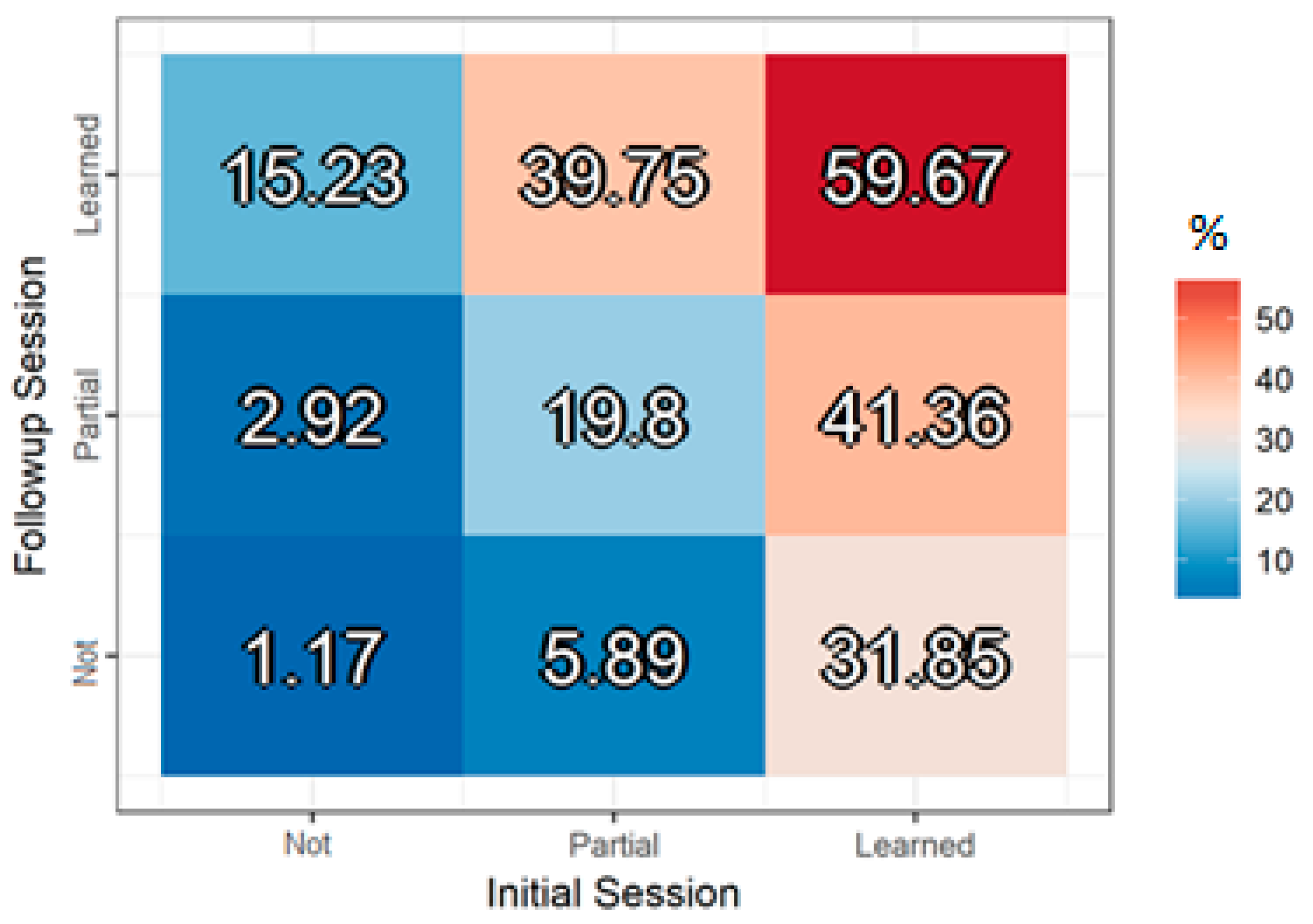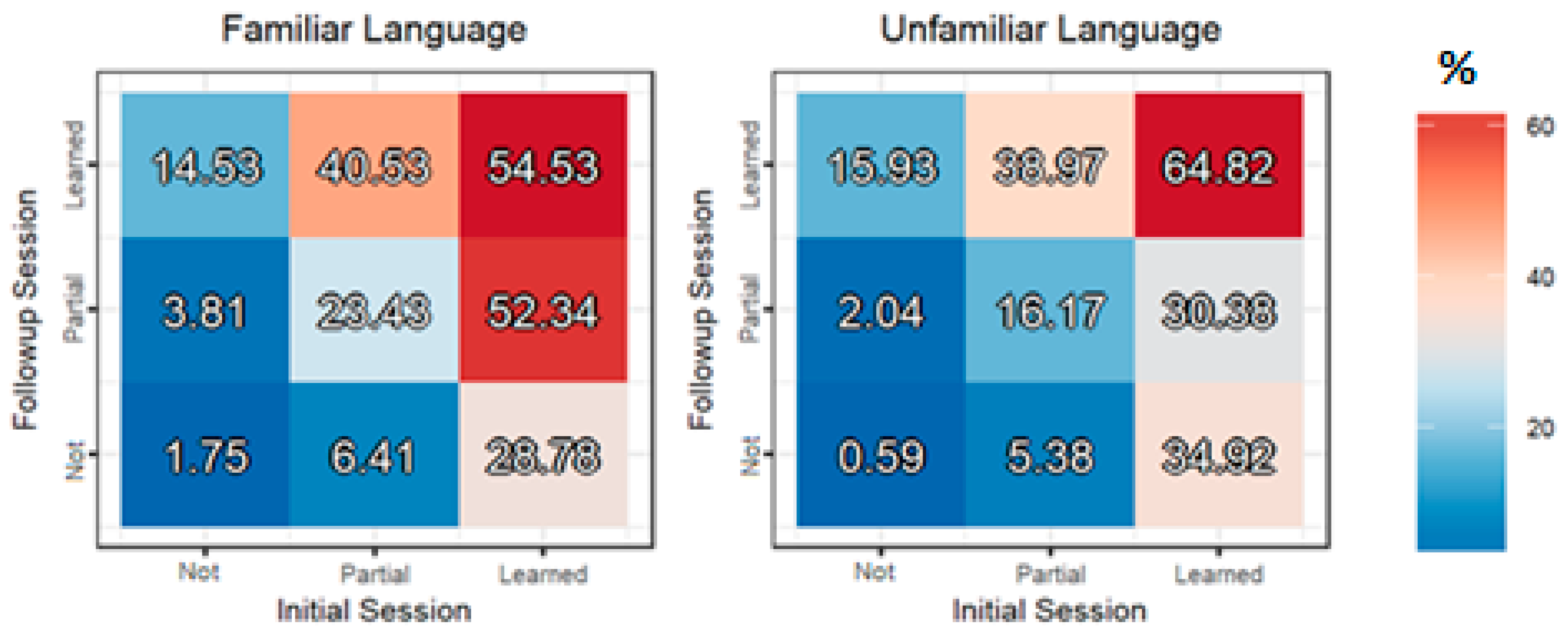Language Difficulty and Prior Learning Influence Foreign Vocabulary Acquisition
Abstract
1. Introduction
2. Materials and Methods
2.1. Participants
2.2. Materials
2.3. Procedure
3. Results
3.1. Word Imageability and Language Familiarity over Time
3.2. Prior Learning, Language Difficulty, and Vocabulary Retention
3.2.1. Prior Learning
3.2.2. Language Familiarity
3.2.3. Imageability
4. Discussion
Author Contributions
Funding
Conflicts of Interest
References
- Agarwal, Pooja K., Jason R. Finley, Nathan S. Rose, and Henry L. Roediger. 2017. Benefits from Retrieval Practice Are Greater for Students with Lower Working Memory Capacity. Memory 25: 764–71. [Google Scholar] [CrossRef]
- Altarriba, Jeanette, Lisa M. Bauer, and Claudia Benvenuto. 1999. Concreteness, Context Availability, and Imageability Ratings and Word Associations for Abstract, Concrete, and Emotion Words. Behavior Research Methods, Instruments & Computers 31: 578–602. [Google Scholar] [CrossRef]
- Atkinson, Richard C. 1972. Optimizing the Learning of a Second-Language Vocabulary. Journal of Experimental Psychology 96: 124–29. [Google Scholar] [CrossRef]
- Barcroft, Joe. 2002. Semantic and Structural Elaboration in L2 Lexical Acquisition. Language Learning 52: 323–63. [Google Scholar] [CrossRef]
- Barcroft, Joe. 2004. Second Language Vocabulary Acquisition: A Lexical Input Processing Approach. Foreign Language Annals 37: 200–8. [Google Scholar] [CrossRef]
- Bartolotti, James, and Viorica Marian. 2017. Orthographic Knowledge and Lexical Form Influence Vocabulary Learning. Applied Psycholinguistics 38: 427–56. [Google Scholar] [CrossRef]
- Bates, Douglas, Martin Mächler, Ben Bolker, and Steve Walker. 2015. Fitting Linear Mixed-Effects Models Using lme4. Journal of Statistical Software 67. [Google Scholar] [CrossRef]
- Bird, Helen, Sue Franklin, and David Howard. 2001. Age of Acquisition and Imageability Ratings for a Large Set of Words, Including Verbs and Function Words. Behavior Research Methods, Instruments, and Computers 33: 73–79. [Google Scholar] [CrossRef]
- Bjork, Robert A. 1994. Memory and Metamemory Considerations in the Training of Human Beings. In Metacognition: Knowing about Knowing. Edited by Janet Metcalfe and Arthur P. Shimamura. Cambridge: MIT Press, pp. 185–205. [Google Scholar]
- Bjork, Elizabeth L., and Robert A. Bjork. 2011. Making Things Hard on Yourself, but in a Good Way: Creating Desirable Difficulties to Enhance Learning. Psychology and the Real World: Essays Illustrating Fundamental Contributions to Society 2: 59–68. [Google Scholar]
- Brysbaert, Marc, and Boris New. 2009. Moving beyond Kučera and Francis: A Critical Evaluation of Current Word Frequency Norms and the Introduction of a New and Improved Word Frequency Measure for American English. Behavior Research Methods 41: 977–90. [Google Scholar] [CrossRef]
- Bui, Dung C., Geoffrey B. Maddox, and David A. Balota. 2013. The Roles of Working Memory and Intervening Task Difficulty in Determining the Benefits of Repetition. Psychonomic Bulletin and Review 20: 341–47. [Google Scholar] [CrossRef]
- Chow, Bonnie Wing Yin. 2018. The Developmental Transition from Holistic to Analytic Character Learning in Child Readers of Chinese. Learning and Individual Differences 67: 126–31. [Google Scholar] [CrossRef]
- Council of Europe. 2001. Common European Framework of Reference for Languages: Learning, Teaching, Assessment. Cambridge: Cambridge University Press. [Google Scholar]
- Crossley, Scott, Kristopher Kyle, and Thomas Salsbury. 2016. A Usage-Based Investigation of L2 Lexical Acquisition: The Role of Input and Output. The Modern Language Journal 100: 702–15. [Google Scholar] [CrossRef]
- de Groot, Annette M. B. 2006. Effects of Stimulus Characteristics and Background Music on Foreign Language Vocabulary Learning and Forgetting. Language Learning 56: 463–506. [Google Scholar] [CrossRef]
- de Groot, Annette M. B., and Rineke Keijzer. 2000. What Is Hard to Learn Is Easy to Forget: The Roles of Word Concreteness, Cognate Status, and Word Frequency in Foreign-Language Vocabulary Learning and Forgetting. Language Learning 50: 1–56. [Google Scholar] [CrossRef]
- de Groot, Annette M. B., and Janet G. van Hell. 2005. The Learning of Foreign Language Vocabulary. In Handbook of Bilingualism: Psycholinguistic Approaches. Edited by Annette de Groot and Judith Kroll. New York: Oxford University Press, pp. 9–29. [Google Scholar]
- de la Fuente, María José. 2002. Negotiation and Oral Acquisition of L2 Vocabulary. Studies in Second Language Acquisition 24: 81–112. [Google Scholar] [CrossRef]
- Dewaele, Jean-Marc, Konstantinos V. Petrides, and Adrian Furnham. 2008. Effects of Trait Emotional Intelligence and Sociobiographical Variables on Communicative Anxiety and Foreign Language Anxiety among Adult Multilinguals: A Review and Empirical Investigation. Language Learning 58: 911–60. [Google Scholar] [CrossRef]
- Duddington, Jonathan. 2012. ESpeak. Available online: http://espeak.sourceforge.net/ (accessed on 1 November 2016).
- Elgort, Irina, and Paul Warren. 2014. L2 Vocabulary Learning from Reading: Explicit and Tacit Lexical Knowledge and the Role of Learner and Item Variables. Language Learning 64: 365–414. [Google Scholar] [CrossRef]
- Ellis, Nick C., and Alan Beaton. 1993. Psycholinguistic Determinants of Foreign Language Vocabulary Learning. Language Learning 43: 559–617. [Google Scholar] [CrossRef]
- Gardner, Robert C., Richard N. Lalonde, and R. Moorcroft. 1985. The Role of Attitudes and Motivation in Second Language Learning: Correlational and Experimental Considerations. Language Learning 35: 207–27. [Google Scholar] [CrossRef]
- Gathercole, Susan E., Clive R. Frankish, Susan J. Pickering, and Sarah Peaker. 1999. Phonotactic Influences on Short-Term Memory. Journal of Experimental Psychology: Learning, Memory, and Cognition 25: 84–95. [Google Scholar] [CrossRef] [PubMed]
- Godwin-Jones, Robert. 2018. Contextualized Vocabulary Learning. Language Learning & Technology 22: 1–19. [Google Scholar]
- Gunter, Glenda A., Laurie O. Campbell, Junia Braga, Marcos Racilan, and Valeska Virgínia S. Souza. 2016. Language Learning Apps or Games: An Investigation Utilizing the RETAIN Model. Revista Brasileira de Linguística Aplicada 16: 209–35. [Google Scholar] [CrossRef][Green Version]
- Herman, Frank. 2003. Differential Effects of Reading and Memorization of Paired Associates on Vocabulary Acquisition in Adult Learners of English as a Second Language. TESL-EJ 7: 1–15. [Google Scholar]
- Janiszewski, Chris, Hayden Noel, and Alan G. Sawyer. 2003. A Meta-Analysis of the Spacing Effect in Verbal Learning: Implications for Research on Advertising Repetition and Consumer Memory. Journal of Consumer Research 30: 138–49. [Google Scholar] [CrossRef]
- Joe, Angela. 1995. Text-Based Tasks and Incidental Vocabulary Learning. Second Language Research 11: 149–58. [Google Scholar] [CrossRef]
- Kachergis, George, Marjorie Rhodes, and Todd Gureckis. 2017. Desirable Difficulties during the Development of Active Inquiry Skills. Cognition 166: 407–17. [Google Scholar] [CrossRef] [PubMed][Green Version]
- Kasahara, Kiwamu. 2011. The Effect of Known-and-Unknown Word Combinations on Intentional Vocabulary Learning. System 39: 491–99. [Google Scholar] [CrossRef]
- Kaushanskaya, Margarita, and Viorica Marian. 2009. The Bilingual Advantage in Novel Word Learning. Psychonomic Bulletin & Review 16: 705–10. [Google Scholar] [CrossRef]
- Kaushanskaya, Margarita, and Katrina Rechtzigel. 2012. Concreteness Effects in Bilingual and Monolingual Word Learning. Psychonomic Bulletin & Review 19: 935–41. [Google Scholar] [CrossRef]
- Kaushanskaya, Margarita, Jeewon Yoo, and Stephanie Van Hecke. 2013. Word Learning in Adults With Second-Language Experience: Effects of Phonological and Referent Familiarity. Journal of Speech Language and Hearing Research 56: 667–78. [Google Scholar] [CrossRef][Green Version]
- Khoii, Roya, and Samira Sharififar. 2013. Memorization Versus Semantic Mapping in L2 Vocabulary Acquisition. ELT Journal 67: 199–209. [Google Scholar] [CrossRef]
- Ko, Myong Hee, and John Goranson. 2014. Technology-Assisted Vocabulary Learning and Student Learning Outcomes: A Case Study. Multimedia-Assisted Language Learning 17: 11–33. [Google Scholar]
- Kroll, Judith, and Erika Stewart. 1994. Category Interference in Translation and Picture Naming: Evidence for Asymmetric Connections between Bilingual Memory Representations. Journal of Memory and Language 33: 149–74. [Google Scholar] [CrossRef]
- Laufer, Batia, and Jan Hulstijn. 2001. Incidental Vocabulary Acquisition in a Second Language: The Construct of Task-Induced Involvement. Applied Linguistics 22: 1–26. [Google Scholar] [CrossRef]
- Lotto, Lorella, and Annette M. B. de Groot. 1998. Effects of Learning Method and Word Type on Acquiring Vocabulary in an Unfamiliar Language. Language Learning 48: 31–69. [Google Scholar] [CrossRef]
- Ma, Weiyi, Roberta M. Golinkoff, Kathy Hirsh-Pasek, Colleen McDonough, and Twila Tardif. 2009. Imageability Predicts the Age of Acquisition of Verbs in Chinese Children. Journal of Child Language 36: 405–423. [Google Scholar] [CrossRef]
- MacIntyre, Peter. 2002. Motivation, Anxiety and Emotion in Second Language Acquisition. Language Learning & Language Teaching, 45–68. [Google Scholar] [CrossRef]
- MacIntyre, Peter, and Tammy Gregersen. 2012. Affect: The Role of Language Anxiety and Other Emotions in Language Learning. In Psychology for Language Learning. Edited by Sarah Mercer, Stephen Ryan and Marion Williams. London: Palgrave Macmillan, pp. 103–18. [Google Scholar] [CrossRef]
- Marian, Viorica, Henrike K. Blumenfeld, and Margarita Kaushanskaya. 2007. The Language Experience and Proficiency Questionnaire (LEAP-Q): Assessing Language Profiles in Bilinguals and Multilinguals. Journal of Speech, Language, and Hearing Research 50: 940–67. [Google Scholar] [CrossRef]
- Marian, Viorica, James Bartolotti, Sarah Chabal, and Anthony Shook. 2012. CLEARPOND: Cross-Linguistic Easy-Access Resource for Phonological and Orthographic Neighborhood Densities. PLoS ONE 7: e43230. [Google Scholar] [CrossRef]
- Mestres-Missé, Anna, Thomas F. Münte, and Antoni Rodriguez-Fornells. 2009. Functional Neuroanatomy of Contextual Acquisition of Concrete and Abstract Words. Journal of Cognitive Neuroscience 21: 2154–71. [Google Scholar] [CrossRef] [PubMed]
- Mokhtar, Ahmad Azman, Rafizah Mohd Rawian, Mohamad Fadhili Yahaya, Azaharee Abdullah, and Abdul Rashid Mohamed. 2000. Vocabulary Learning Strategies of Adult ESL Learners. The English Teacher XXXVIII: 133–44. [Google Scholar]
- Oxford, Rebecca, and David Crookall. 1990. Vocabulary Learning: A Critical Analysis of Techniques. TESL Canada Journal 7: 9–30. [Google Scholar] [CrossRef]
- Oxford, Rebecca, Yunkyoung Cho, Santoi Leung, and Hae Jin Kim. 2004. Effect of the Presence and Difficulty of Task on Strategy Use: An Exploratory Study. IRAL—International Review of Applied Linguistics in Language Teaching 42: 1–47. [Google Scholar] [CrossRef]
- Paivio, Allan. 1990. Mental Representations: A Dual Coding Approach. Oxford: Oxford University Press. [Google Scholar]
- Paribakht, Tahereh S., and Marjorie Wesche. 1997. Vocabulary Enhancement Activities and Reading for Meaning in Second Language Vocabulary Acquisition. In Second Language Vocabulary Acquisition: A Rationale for Pedagogy. Cambridge: Cambridge University Press, pp. 174–200. [Google Scholar]
- Peters, Elke. 2019. Factors Affecting the Learning of Single-word Items. In The Routledge Handbook of Vocabulary Studies. Edited by Stuart Webb. New York: Routledge, pp. 125–42. [Google Scholar]
- Pichette, François, Linda de Serres, and Marc Lafontaine. 2012. Sentence Reading and Writing for Second Language Vocabulary Acquisition. Applied Linguistics 33: 66–82. [Google Scholar] [CrossRef]
- Potts, Rosalind, and David R. Shanks. 2014. The Benefit of Generating Errors during Learning. Journal of Experimental Psychology 143: 644–67. [Google Scholar] [CrossRef]
- Puimège, Eva, and Elke Peters. 2019. Learners’ English Vocabulary Knowledge Prior to Formal Instruction: The Role of Learner-Related and Word-Related Variables. Language Learning 69: 943–77. [Google Scholar] [CrossRef]
- R Core Team. 2015. R: A Language and Environment for Statistical Computing. Vienna: R Foundation for Statistical Computing. Available online: http://www.r-project.org (accessed on 30 May 2018).
- Richardson, John T. E. 1975. Concreteness and Imageability. Quarterly Journal of Experimental Psychology 27: 235–49. [Google Scholar] [CrossRef]
- Ringbom, Håkan, and Scott Jarvis. 2009. The Importance of Cross-Linguistic Similarity in Foreign Language Learning. In The Handbook of Language Teaching. Edited by Michael H. Long and Catherine J. Doughty. Madden: Wiley-Blackwell, pp. 106–18. [Google Scholar] [CrossRef]
- Sagarra, Nuria, and Matthew Alba. 2006. The Key Is in the Keyword: L2 Vocabulary Learning Methods with Beginning Learners of Spanish. Modern Language Journal 90: 228–43. [Google Scholar] [CrossRef]
- Schmitt, Norbert. 2010. Researching Vocabulary: A Vocabulary Research Manual. London: Palgrave Macmillan. [Google Scholar]
- Schneider, Vivian I., Alice F. Healy, and Lyle E. Bourne. 2002. What Is Learned under Difficult Conditions Is Hard to Forget: Contextual Interference Effects in Foreign Vocabulary Acquisition, Retention, and Transfer. Journal of Memory and Language 46: 419–40. [Google Scholar] [CrossRef]
- Schwanenflugel, Paula J., and Edward J. Shoben. 1983. Differential Context Effects in the Comprehension of Abstract and Concrete Verbal Materials. Journal of Experimental Psychology: Learning, Memory, and Cognition 9: 82–102. [Google Scholar] [CrossRef]
- Shea, John B., and Robyn L. Morgan. 1979. Contextual Interference Effects on the Acquisition, Retention, and Transfer of a Motor Skill. Journal of Experimental Psychology: Human Learning and Memory 5: 179–87. [Google Scholar] [CrossRef]
- Smith, Steven M., Arthur Glenberg, and Robert A. Bjork. 1978. Environmental Context and Human Memory. Memory & Cognition 6: 342–53. [Google Scholar] [CrossRef]
- Soderstrom, Nicholas C., and Robert A. Bjork. 2015. Learning versus Performance: An Integrative Review. Perspectives on Psychological Science 10: 176–99. [Google Scholar] [CrossRef] [PubMed]
- Stadthagen-Gonzalez, H, and Colin J. Davis. 2006. The Bristol Norms for Age of Acquisition, Imageability, and Familiarity. Behavior Research Methods 38: 598–605. [Google Scholar] [CrossRef]
- Storkel, Holly L. 2001. Learning New Words: Phonotactic Probability in Language Development. Journal of Speech, Language, and Hearing Research 44: 1321–37. [Google Scholar] [CrossRef]
- Storm, Benjamin C., Michael C. Friedman, Kou Murayama, and Robert A. Bjork. 2014. On the Transfer of Prior Tests or Study Events to Subsequent Study. Journal of Experimental Psychology: Learning Memory and Cognition 40: 115–24. [Google Scholar] [CrossRef]
- Tagashira, Kenji. 2001. What Is Hard to Learn Is Easy to Forget? : Word Concreteness in Foreign-Language Vocabulary Forgetting. ARELE : Annual Review of English Language Education in Japan 12: 91–100. [Google Scholar] [CrossRef]
- van Hell, Janet G., and Andrea Candia Mahn. 1997. Keyword Mnemonics versus Rote Rehearsal: Learning Concrete and Abstract Foreign Words by Experienced and Inexperienced Learners. Language Learning 47: 507–46. [Google Scholar] [CrossRef]
- van Zeeland, Hilde, and Norbert Schmitt. 2013. Incidental Vocabulary Acquisition through L2 Listening: A Dimensions Approach. System 41: 609–24. [Google Scholar] [CrossRef]
- Wu, Jianxiong. 2015. A Crowdsourcing Approach to Chinese Vocabulary Learning. IALLT Journal of Language Learning Technologies 44: 43–63. [Google Scholar] [CrossRef]
| 1 | Note that de Groot and Keijzer (2000) characterized the measure as concreteness, but the stimuli were in fact categorized based on imageability ratings. |
| 2 | Including either a categorical (Monolingual vs. Not) or continuous (Non-English Proficiency) variable as a predictor did not alter the significance of the reported effects, and there were no significant effects or interactions with Language Status (p > 0.05). Though including Non-English Proficiency as a continuous predictor did yield a significant three-way interaction between Proficiency, Imageability, and Session (F(2, 9103) = 3.58, p = 0.028), Holm–Bonferroni-adjusted follow-up tests revealed no significant interactions between Proficiency and Imageability in Session 1 (p > 0.9), Session 2 (p = 0.24), or Session 3 (p = 0.14). Similarly, while there was a significant three-way interaction between Proficiency, Familiarity, and Session (F(2, 9111.1) = 4.28, p = 0.014), the lower-order effects of Proficiency did not approach significance in any of the sessions (p > 0.9). |




| Estimate | SE | Df | t | p | ||
|---|---|---|---|---|---|---|
| Intercept | 9.90 | 1.50 | 105.60 | 6.56 | <0.001 | *** |
| Initial:Learn | 17.80 | 2.40 | 2992.97 | 7.52 | <0.001 | *** |
| Initial:Complete | 20.50 | 4.20 | 2982.22 | 4.93 | <0.001 | *** |
| Followup:Learn | 12.00 | 2.00 | 2995.05 | 6.04 | <0.001 | *** |
| Followup:Complete | 16.50 | 3.10 | 2974.32 | 5.27 | <0.001 | *** |
| Familiarity | 0.70 | 2.00 | 78.37 | 0.36 | 0.717 | |
| Imageability | 4.50 | 1.10 | 2951.47 | 4.25 | <0.001 | *** |
| Initial:Learn|Followup:Learn | 11.30 | 4.60 | 2981.10 | 2.46 | 0.014 | * |
| Initial:Complete|Followup:Learn | 0.10 | 7.90 | 2974.25 | 0.02 | 0.988 | |
| Initial:Learn|Followup:Complete | 7.70 | 6.30 | 2957.39 | 1.21 | 0.227 | |
| Initial:Complete|Followup:Complete | 1.30 | 9.30 | 2952.61 | 0.14 | 0.888 | |
| Initial:Learn|Familiarity | −0.50 | 2.70 | 2995.89 | −0.17 | 0.863 | |
| Initial:Complete|Familiarity | −4.20 | 4.60 | 2981.48 | −0.92 | 0.359 | |
| Followup:Learn|Familiarity | 1.90 | 2.30 | 2988.85 | 0.83 | 0.404 | |
| Followup:Complete|Familiarity | −7.90 | 3.40 | 2977.97 | −2.33 | 0.02 | * |
| Initial:Learn|Imageability | 11.70 | 2.50 | 2952.53 | 4.62 | <0.001 | *** |
| Initial:Complete|Imageability | 10.70 | 4.40 | 2955.08 | 2.43 | 0.015 | * |
| Followup:Learn|Imageability | 0.60 | 2.10 | 2954.66 | 0.26 | 0.792 | |
| Followup:Complete|Imageability | 4.90 | 3.20 | 2964.57 | 1.52 | 0.129 | |
| Initial:Learn|Followup:Learn|Familiarity | 8.70 | 5.10 | 2990.06 | 1.71 | 0.088 | |
| Initial:Complete|Followup:Learn|Familiarity | 8.60 | 8.40 | 2975.03 | 1.02 | 0.308 | |
| Initial:Learn|Followup:Complete|Familiarity | −15.80 | 6.60 | 2958.09 | −2.41 | 0.016 | * |
| Initial:Complete|Followup:Complete|Familiarity | −26.60 | 8.80 | 2947.61 | −3.02 | 0.003 | ** |
| Initial:Learn|Followup:Learn|Imageability | −4.60 | 4.90 | 2954.56 | −0.94 | 0.347 | |
| Initial:Complete|Followup:Learn|Imageability | −19.30 | 8.10 | 2952.95 | −2.37 | 0.018 | * |
| Initial:Learn|Followup:Complete|Imageability | 14.10 | 6.20 | 2958.59 | 2.26 | 0.024 | * |
| Initial:Complete|Followup:Complete|Imageability | 20.70 | 8.30 | 2958.09 | 2.50 | 0.013 | * |
© 2019 by the authors. Licensee MDPI, Basel, Switzerland. This article is an open access article distributed under the terms and conditions of the Creative Commons Attribution (CC BY) license (http://creativecommons.org/licenses/by/4.0/).
Share and Cite
Hayakawa, S.; Bartolotti, J.; van den Berg, A.; Marian, V. Language Difficulty and Prior Learning Influence Foreign Vocabulary Acquisition. Languages 2020, 5, 2. https://doi.org/10.3390/languages5010002
Hayakawa S, Bartolotti J, van den Berg A, Marian V. Language Difficulty and Prior Learning Influence Foreign Vocabulary Acquisition. Languages. 2020; 5(1):2. https://doi.org/10.3390/languages5010002
Chicago/Turabian StyleHayakawa, Sayuri, James Bartolotti, Aimee van den Berg, and Viorica Marian. 2020. "Language Difficulty and Prior Learning Influence Foreign Vocabulary Acquisition" Languages 5, no. 1: 2. https://doi.org/10.3390/languages5010002
APA StyleHayakawa, S., Bartolotti, J., van den Berg, A., & Marian, V. (2020). Language Difficulty and Prior Learning Influence Foreign Vocabulary Acquisition. Languages, 5(1), 2. https://doi.org/10.3390/languages5010002




